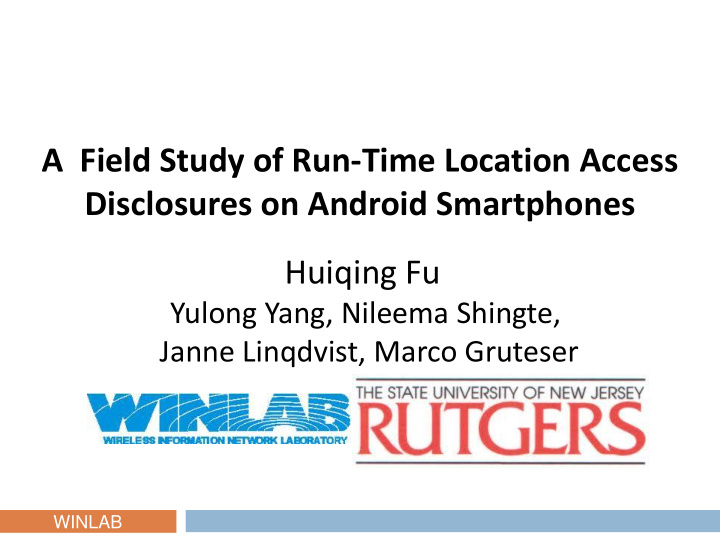



A Field Study of Run-Time Location Access Disclosures on Android Smartphones Huiqing Fu Yulong Yang, Nileema Shingte, Janne Linqdvist, Marco Gruteser WINLAB
Why Run-Time Location Access Disclosures on Smartphones? 2 Large amount of users use Android phones (76 million Android users in US) 74% smartphone users use location-based services Users are interested to know about their location usage by apps Previous technical report showed that more than 70% of participants (n=791) desired to know about location data collection by apps on mobile devices (Balebako 2013) Feedback is one of the two principles in privacy design (Bellotti 1993) and immediate notifications was effective to inform users about location request for contextual instant messaging (Hsieh 2007)
Existing Location Access Disclosures 3 Android permissions at installation time Permissions are not effective Users ignore the permission list Users do not understand the permissions
Existing Location Access Disclosures 4 Android GPS icon flashing at run-time When the app is trying to update location using GPS, the GPS icon flashes on the upper left corner Effectiveness? Unknown
Problems To Explore in Field Study 5 What is the effectiveness of Android GPS icon flashing at run-time? What better run-time location access disclosure methods should be? What are users’ reactions if they were notified of their apps accessing location in daily life? We note that these apps are used of their own choice on their own phones.
Solutions: User Level Study App 6 User level study app can be installed on participants’ phones without any changes Detect apps’ location access at run -time No changes to participants’ phones
Study App’s Disclosure Features 7 Run-time location access disclosure features Notifications in the notice bar Toast notification on screen App’s Name App’s Icon
Four-Week Field Study 8 Recruitment Flyers, Mailing list, craigslist, enrollment on campus Study Procedures Entry Interview Install study app 4 weeks intervention in daily life Exit Interview
Four-Week Field Study 9 Assign randomly to two groups before entry interview Totally 22 participants in two groups to analyze No Disclosure group (n=9) Disclosure group (n=13)
Results: Apps Unexpected to Access Location 10 Almost all participants had several apps unexpected to access location in both groups 12 out of 13 participants in the Disclosure group unexpected some apps to access location Mean of number of apps: 6.4, sd=5.4 8 out of 9 participants in the No Disclosure group unexpected some apps to access location Mean of number of apps: 5.7, sd=3.3
Results: Reactions in the Disclosure Group 11 Uninstall apps after receiving disclosures P11 uninstalled a Launcher App unexpected to access location “a launcher app did not need location for its function” Uninstall app was an extreme action, the apps were not available on the phones any more after being uninstalled.
Results: Reactions in the Disclosure Group 12 Uninstall apps after receiving disclosure notifications P4 uninstalled 3 game apps “ not like these apps accessing location, not need these apps any more”
Results: Reactions in the Disclosure Group 13 Stop using some apps after receiving disclosure notifications P4 and P5 stopped playing some games unexpected to access location “If a game access my location I will not play the game anymore.” No!
Results: Reactions in the Disclosure Group 14 Reduce frequency of using some apps P6 tried to use other apps to replace the apps unexpected to access location by using other apps “not have “would pay reasons to attention to access these apps and location” use them more carefully ”
Results: Reactions in the Disclosure Group 15 Disable location access setup for the app P2 disabled location access of a game app unexpected to access location “still worked well after location being disabled” Game AppX Setup Location OFF Most participants might prefer this action, but participants assumed most apps did not give the option to disable location
Disclosure group Learned How Apps Used Their Location Data 16 Apps’ location usage learned from run -time disclosure Participants learned how often each app accessed location. They might make different decisions depending the frequency. “I would like to know the times each app accessed location… if I know some apps access my location too often, I would probably stop using them.” “Your app used to notify me … which of the app was accessing location at what time. Sometimes I was surprised, oh this app used my location sort of that way .”
Disclosure Group Appreciated the Transparency 17 Transparency brought by the run-time disclosure was appreciated by participants in the Disclosure group Most participants would like to be aware of what was happening on their phones Eye “Actually it made Opener me more aware of what was going on. I appreciated that .” Most participants would like to continue receiving the notifications in the notice bar
Questions? 18 Thank You !
Recommend
More recommend